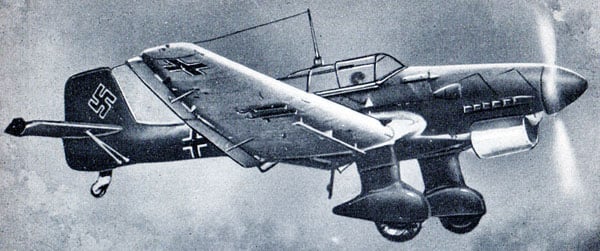The Junkers Ju 87 Stuka was one of the most terrifying weapons in the early stages of the war. The Stuka was a dive bomber designed by the Junkers aircraft company that became one of the most recognizable sights of the war. Do you know what is Unique about the German JU-87?
The infamous sound made by German JU-87 dive bombers while in a dive was caused by a siren installed on the plane, rather than just the sound of the plane diving on a bomb run.
All About the JU-87
The Junkers Ju 87, also known as the Stuka which is German for dive bomber. It was a German dive bomber and ground-attack aircraft. It took to the skies for the first time in 1935. During the Spanish Civil War of 1936-1939, the Ju 87 made its combat debut with the Luftwaffe’s Condor Legion, and it later served in Axis forces during World War II.
The aircraft’s inverted gull wings and fixed spatted undercarriage make it easily identifiable. Mounted on the leading edges of its faired main gear legs were ram-air sirens known as Jericho trumpets, which became a propaganda symbol of German air power and the so-called Blitzkrieg victories of 1939 to 1942, well as providing audible feedback to Stuka pilots.
The aircraft’s inverted gull wings and fixed spatted undercarriage make it easily identifiable. Mounted on the leading edges of its faired main gear legs were ram-air sirens known as Jericho trumpets, which became a propaganda symbol of German air power and the so-called Blitzkrieg victories of 1939–1942, well as providing audible feedback to Stuka pilots.
Following the fall of France, it was used to attack shipping on the English Channel. The Ju87 was responsible for more ship sinkings than any other aircraft. Stuka units then focused on coastal airfields and radar stations, but by August 1940, heavy losses from defending fighters forced them to withdraw from operations. This poorly armed, slow, and highly vulnerable aircraft could not operate without air superiority over the battlefield. (Source: Air Force Mag)
What are the JU-87 Sirens for?
It’s the sound of a plane hitting the ground. Still, it was first associated with a very specific plane for a very specific reason, and the Nazi Luftwaffe simply wanted to scare the bejeezus out of English and Russian civilians.
The Junkers 87-B dive bomber was the Nazis’ first mass-produced fighter aircraft at the start of World War II, having been perfected in the Spanish Civil War and ready to take on the French, British, and, later, the Red Army.
It was more about the sound the dive bomber made when zooming toward an earthbound target than its ability in the air, which was top of the line for the time. It was dubbed the Jericho Trumpet by the Nazis, completely unnecessary.
It was all for propaganda purposes. Sirens were attached to the leading edge of the wings, just ahead of the Stuka’s fixed landing gear. The sound was designed to be memorable, weaken enemy morale, and instill widespread fear of the German dive-bomber.
The only issue with the Jericho Trumpets was that they messed with the Junker 87-B’s aerodynamics, causing enough drag to slow the plane down by 20 miles per hour and making them easier targets for defenders. The Sirens were eventually retired, and whistles were installed on the bombs to achieve the same psychological effect. (Source: We Are The Mighty)
